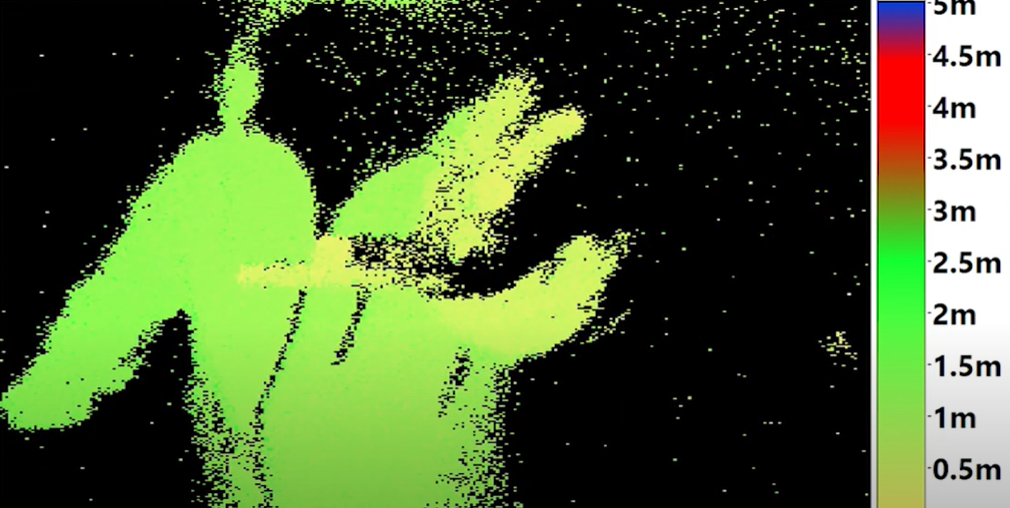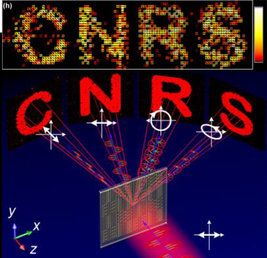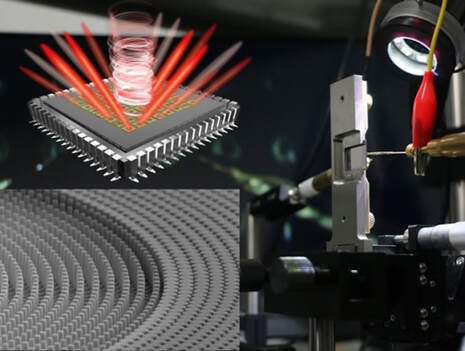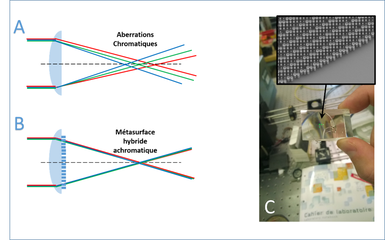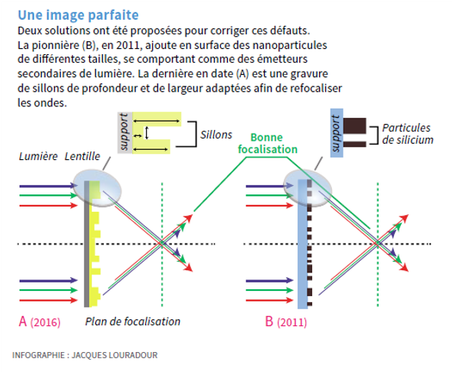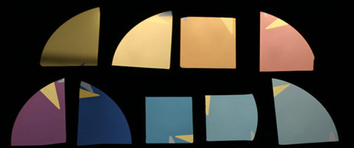Un système d’imagerie 3D à large champ de vision pour la robotique et l’automobile
Une équipe du CRHEA propose une technologie de LiDAR - un dispositif d'imagerie 3D - qui répond aux exigences de l'industrie automobile. Compacts, capables de balayer à haute fréquence un large champ de vision, ces LiDARs de nouvelle génération pourraient équiper des voitures autonomes, mais aussi des robots, des drones et tout autre appareil mobile.
https://www.cnrsinnovation.com/actualite/un-systeme-dimagerie-3d-a-large-champ-de-vision-pour-la-robotique-et-lautomobile/ |
’Transmogrifying’ mirrors created with nanoscale patterning
|
"Ptychography reveals the potential of vectorial metasurfaces"
|
"Metasurfaces help shape laser beams"
LIKE OTHER LASERS, VCSELS CONTAIN A CAVITY IN WHICH LIGHT IS GENERATED AND EMITTED TO PRODUCE STIMULATED EMISSION. THIS CAVITY IS SANDWICHED BETWEEN TWO MIRRORS THAT PROVIDE THE OPTICAL FEEDBACK NECESSARY FOR LASING. IN VCSELS, HOWEVER, THE LASER CAVITY IS VERY SMALL, AT JUST A FEW MICRONS THICK. THIS SMALL SIZE GIVES THE LASER ITS SWITCHING SPEED, BUT IT ALSO MAKES IT HARD TO PRECISELY CONTROL THE SHAPE OF THE LIGHT BEAM EMITTED. THIS IS BECAUSE LIGHT DIFFRACTS AROUND FEATURES THE SAME SIZE AS ITS WAVELENGTH, WHICH MAKES IT DIFFICULT TO RESOLVE, AND THUS CONTROL, SMALLER DETAILS. METASURFACE CONTINUALLY SHAPES WAVEFRONT LASER BEAM SHAPING – THAT IS, REDISTRIBUTING THE LASER’S INTENSITY ACROSS THE BEAM’S PROFILE – IS IMPORTANT FOR APPLICATIONS SUCH AS LASER MACHINING OR MEDICAL DEVICES THAT REQUIRE LASER LIGHT SHAPED IN ONLY ONE AXIS. RESEARCHERS LED BY PATRICE GENEVET OF THE CENTRE DE RECHERCHE SUR L’HÉTÉRO-EPITAXIE ET SES APPLICATIONS (CRHEA) AT THE UNIVERSITY CÔTE D’AZUR AND COLLABORATORS AT THE KEY LABORATORY OF OPTOELECTRONICS TECHNOLOGY AT THE BEIJING UNIVERSITY OF TECHNOLOGY HAVE NOW DEMONSTRATED A WAY TO ACHIEVE THIS CONTROL IN VCSELS USING FLAT, ULTRA-THIN OPTICAL STRUCTURES CALLED METALENSES. READ MORE HERE : https://physicsworld.com/a/metasurfaces-help-shape-laser-beams/ Also see the INP scientific actu: https://www.inp.cnrs.fr/fr/node/2232 |
"Des composants hybrides pour corriger les aberrations chromatiques"
Read More at:
(INP, CNRS): inp.cnrs.fr/fr/cnrsinfo/des-composants-hybrides-pour-corriger-les-aberrations-chromatiques |
"Les lentilles plates discutées dans le journal le Monde" |
¨Surfing a wake of light
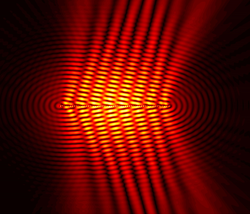
In the Cherenkov effect a charged particle moving with a velocity faster than the phase velocity of light in the medium radiates light that forms a cone with a half angle determined by the ratio of the two speeds. Here, we show that by creating a running wave of polarization along a one-dimensional metallic nanostructure consisting of subwavelength spaced rotated apertures that propagates faster than the surface plasmon polariton phase velocity, we can generate surface plasmon wakes, a two-dimensional analogue of Cherenkov radiation. The running wave of polarization travels with a speed determined by the angle of incidence and the photon spin angular momentum of the incident radiation. By changing either one of these properties we demonstrate controlled steering of the Cherenkov surface plasmon wakes.
Read more at:
(Harvard SEAS website) http://www.seas.harvard.edu/news/2015/07/surfing-wake-of-light
(Photonics.com) http://www.sciencenewsline.com/summary/2015070620190013.html
See also our new
Read more at:
(Harvard SEAS website) http://www.seas.harvard.edu/news/2015/07/surfing-wake-of-light
(Photonics.com) http://www.sciencenewsline.com/summary/2015070620190013.html
See also our new
¨Multi-wavelength photonic surfaces,
dispersion management at interfaces
 Ordinary refractive lenses (left) suffer from significant chromatic aberrations as different wavelengths are focused in different spots. To compensate for this chromatic dispersion, additional lenses have to be added in an objective to compensate for chromatic aberrations as the number of wavelengths to be corrected increases. An achromatic doublet corrects for 2 wavelengths, an apochromat for 3 and finally a so called super-achromat for four wavelengths. The Harvard team's new metasurface lenses (right) are designed to focus light in the same spot for 3 different wavelengths with no need to increase the lens thickness and footprint. Copyright © Harvard University.
Ordinary refractive lenses (left) suffer from significant chromatic aberrations as different wavelengths are focused in different spots. To compensate for this chromatic dispersion, additional lenses have to be added in an objective to compensate for chromatic aberrations as the number of wavelengths to be corrected increases. An achromatic doublet corrects for 2 wavelengths, an apochromat for 3 and finally a so called super-achromat for four wavelengths. The Harvard team's new metasurface lenses (right) are designed to focus light in the same spot for 3 different wavelengths with no need to increase the lens thickness and footprint. Copyright © Harvard University.
We overcame an inherent drawback of a wafer-thin lens: light at different wavelengths (i.e., colors) responds to the surface very differently. Until now, this phenomenon has prevented planar optics from being used with broadband light. Now, instead of treating all wavelengths equally, we have devised a flat lens with antennas that compensate for the wavelength differences and produce a consistent effect—for example, deflecting three beams of different colors by the same angle, or focusing those colors on a single spot.
The new lens, dubbed an “achromatic metasurface,” dramatically improves on the flat lens demonstrated in 2012 (see below). That prototype, the first of its kind, corrected for some of the aberrations of conventional lenses but suffered from the limitation of only focusing light of a single wavelength, and its focusing efficiency was small. The new model uses a dielectric material rather than a metal for the nanoantennas, a change which greatly improves its efficiency and, combined with a new design approach, enables operation over a broad range of wavelengths.
Read more at:
(Harvard SEAS website) http://www.seas.harvard.edu/news/2015/02/perfect-colors-captured-with-one-ultra-thin-lens
(Science Daily) http://www.sciencedaily.com/releases/2015/02/150219144647.htm
The new lens, dubbed an “achromatic metasurface,” dramatically improves on the flat lens demonstrated in 2012 (see below). That prototype, the first of its kind, corrected for some of the aberrations of conventional lenses but suffered from the limitation of only focusing light of a single wavelength, and its focusing efficiency was small. The new model uses a dielectric material rather than a metal for the nanoantennas, a change which greatly improves its efficiency and, combined with a new design approach, enables operation over a broad range of wavelengths.
Read more at:
(Harvard SEAS website) http://www.seas.harvard.edu/news/2015/02/perfect-colors-captured-with-one-ultra-thin-lens
(Science Daily) http://www.sciencedaily.com/releases/2015/02/150219144647.htm
¨Optical Chameleon, looking colder when heated
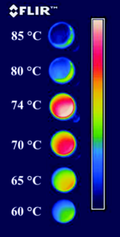
The secret to the technology lies within a very thin film of vanadium oxide, an unusual material that undergoes dramatic electronic changes when it reaches a particular temperature. At room temperature, for example, pure vanadium oxide is electrically insulating, but at slightly higher temperatures it transitions to a metallic, electrically conductive state. During that transition, the optical properties change, too, which means special temperature-dependent effects—like infrared camouflage—can also be achieved.
Read more at:
(Harvard SEAS website) http://www.seas.harvard.edu/news/2013/10/chameleon-in-physics-lab
Read more at:
(Harvard SEAS website) http://www.seas.harvard.edu/news/2013/10/chameleon-in-physics-lab
¨Groovy holograms
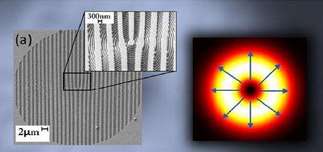 Left: holographic component fabricated by ion milling with a focused ion beam a 150-nanometer-thick gold film deposited on a glass substrate. A laser beam is partially transformed into a radially polarized beam as it traverses the device. The wide grooves create the donut-shaped intensity profile, known as a vortex, while the sub-wavelength nanometer grooves in the inset determine locally the radial polarization, which is perpendicular to the grooves. Right: The computed characteristic beam cross-section; the blue arrows indicate the radial polarization. Copyright © Harvard University.
Left: holographic component fabricated by ion milling with a focused ion beam a 150-nanometer-thick gold film deposited on a glass substrate. A laser beam is partially transformed into a radially polarized beam as it traverses the device. The wide grooves create the donut-shaped intensity profile, known as a vortex, while the sub-wavelength nanometer grooves in the inset determine locally the radial polarization, which is perpendicular to the grooves. Right: The computed characteristic beam cross-section; the blue arrows indicate the radial polarization. Copyright © Harvard University.
We have demonstrated that a single, simple device can been designed to change the intensity, phase, and polarization of light rays using a hologram-like design decorated with nanoscale structures.
As a proof of principle, we created an unusual state of light called a radially polarized beam, which—because it can be focused very tightly—is important for applications like high-resolution lithography and for trapping and manipulating tiny particules like viruses.In this research, we've used holography in a novel way, incorporating cutting-edge nanotechnology in the form of subwavelength structures at a scale of just tens of nanometers to provide us with unique and easy ways for controlling the properties of the diffracted light.
Read more at:
(Harvard SEAS website) http://www.seas.harvard.edu/news/2013/08/groovy-hologram-creates-strange-state-of-light-at-visible-and-invisible-wavelengths
(Phys.org) http://phys.org/news/2013-08-groovy-hologram-strange-state-visible.html
¨Applications of surface wave holography
 This illustration (not to scale) simulates the process by which an incoming complex wave can be identified and transmitted to a photodetector. Copyright © Harvard University.
This illustration (not to scale) simulates the process by which an incoming complex wave can be identified and transmitted to a photodetector. Copyright © Harvard University.
We introduce new functionalities to conventional detector by simply adding a metallic pattern to the window of a commercially available, low-cost photodetector. Each pattern is designed to couple with a particular type of incoming vortex beam by matching its orbital angular momentum—the number of twists per wavelength in an optical vortex.Sensitive to the beam’s “twistiness,” this new detector can effectively distinguish between different types of vortex beams. Existing communications systems maximize bandwidth by sending many messages simultaneously, each a fraction of a wavelength apart; this is known as wavelength division multiplexing. Vortex beams can add an additional level of multiplexing and therefore should expand the capacity of these systems.
Read more at:
(Harvard SEAS website) http://www.seas.harvard.edu/news/2013/01/counting-twists-helical-light-beam
(Photonics.com) http://www.photonics.com/m/Article.aspx?AID=52730
(New Electronics) http://www.newelectronics.co.uk/electronics-technology/a-new-twist-to-optical-communications/48776/
Read more at:
(Harvard SEAS website) http://www.seas.harvard.edu/news/2013/01/counting-twists-helical-light-beam
(Photonics.com) http://www.photonics.com/m/Article.aspx?AID=52730
(New Electronics) http://www.newelectronics.co.uk/electronics-technology/a-new-twist-to-optical-communications/48776/
¨Nanometre-thin optical films.
Change thickness by 15 atoms and you can change the color
|
For centuries it was thought that optical interference patterns, whether from an oily puddle, lens coating, or countless other thin films, could not occur in opaque materials. However, we discovered that even very “lossy” thin films, if atomically thin, can be tailored to reflect a particular range of dramatic and vivid colors
Read more at: (Huffington Post) http://www.huffingtonpost.com/2012/10/14/interference-color-change_n_1965256.html?utm_hp_ref=arts (Harvard Gazette) http://news.harvard.edu/gazette/story/2012/10/seas_applied-physics-as-art/ |
¨Flat lens
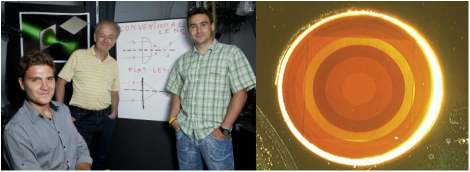
At a mere 60 nanometers thick, the flat lens is essentially two-dimensional, yet its focusing power approaches the ultimate physical limit set by the laws of diffraction.
Operating at telecom wavelengths (i.e., the range commonly used in fiber-optic communications), the new device is completely scalable, from near-infrared to terahertz wavelengths, and simple to manufacture.
Read more at:
(Harvard Gazette) http://www.engadget.com/2012/08/25/harvard-makes-distortion-free-lenses-from-gold-and-silicon/
(The Economist) http://www.economist.com/blogs/babbage/2012/10/revolution-lens-making
(Engadget) http://www.engadget.com/2012/08/25/harvard-makes-distortion-free-lenses-from-gold-and-silicon/
(Wikipedia) https://en.wikipedia.org/wiki/Flat_lens
¨non-diffracting surface waves

The so-called needle beam, the technical term for which is a cosine-Gauss plasmon beam, propagates in tight confinement with a nanostructured metal surface. We found a simple approach to demonstrate the non-diffracting phenomenon by sculpting two sets of grooves into a gold film plated onto the surface of a glass sheet. These tiny grooves intersect at an angle to form a metallic grating which launches two tilted plane surface waves that create the non-diffracting beam.
Read more at:
(Harvard SEAS website) http://www.seas.harvard.edu/news/2012/09/needle-beam-could-eliminate-signal-loss-chip-optics
(News and Views Nature Photonics) http://www.nature.com/nphoton/journal/v6/n11/full/nphoton.2012.271.html
(Photonics.com) http://www.photonics.com/Article.aspx?AID=51790
Read more at:
(Harvard SEAS website) http://www.seas.harvard.edu/news/2012/09/needle-beam-could-eliminate-signal-loss-chip-optics
(News and Views Nature Photonics) http://www.nature.com/nphoton/journal/v6/n11/full/nphoton.2012.271.html
(Photonics.com) http://www.photonics.com/Article.aspx?AID=51790
¨Generalized Snell Laws
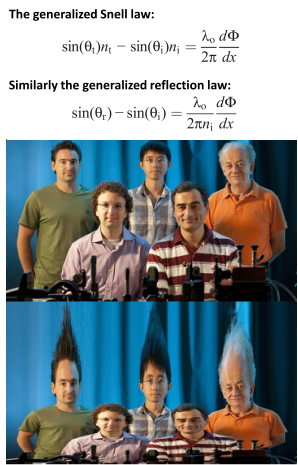 Above: Team members in the top photo include Patrice Genevet (clockwise from left), Nanfang Yu, Federico Capasso, Zeno Gaburro, and Mikhail A. Kats. In the bottom portion of the photo, a simulation of the image that would appear in a large mirror patterned with the team's phase mirror technology.
Copyright © Harvard University
Above: Team members in the top photo include Patrice Genevet (clockwise from left), Nanfang Yu, Federico Capasso, Zeno Gaburro, and Mikhail A. Kats. In the bottom portion of the photo, a simulation of the image that would appear in a large mirror patterned with the team's phase mirror technology.
Copyright © Harvard University
How would a light ray's trajectory change if - at the surface of reflection and refraction - it experienced a position-dependent phase shift?
Adopting the more generalized interpretation of Fermat's Principle, we showed that a position dependent phase shift, say φ(x), imposed at the reflecting-refracting surface can alter the location of stationary phase and, concurrently, the usual optical laws for refraction and reflection.
Read more at:
(Harvard Gazette) http://news.harvard.edu/gazette/story/2011/09/from-a-flat-mirror-designer-light/
(Photonics.com) http://www.photonics.com/Article.aspx?AID=48270
(Physics world) http://physicsworld.com/cws/article/news/2011/sep/02/manipulating-the-middle-ground
(Sciencedaily) http://www.sciencedaily.com/releases/2011/09/110901142106.htm
(Physics Today) http://scitation.aip.org/content/aip/magazine/physicstoday/64/11
